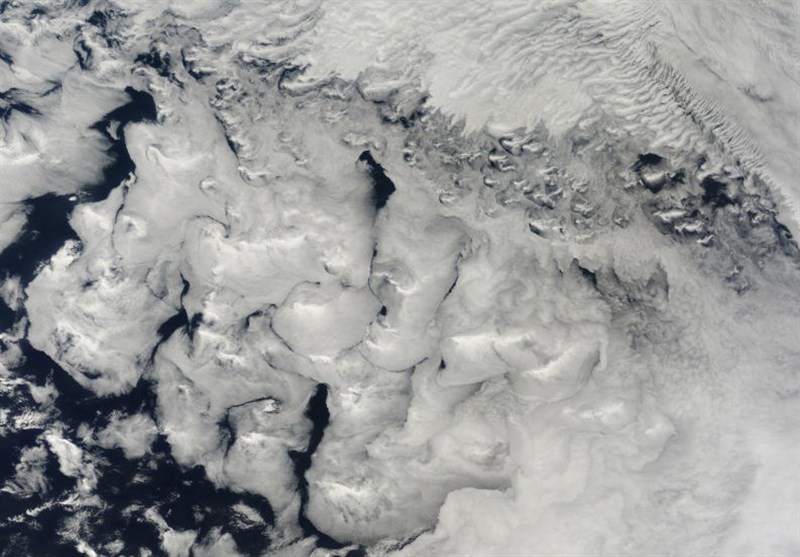Study Shows Extreme Cloud Loss that Cloud Add 8 degrees to Global Warming
TEHRAN (Tasnim) - If atmospheric CO2 levels exceed 1,200 parts per million (ppm), it could push the Earth’s climate over a “tipping point”, finds a new study. This would see clouds that shade large part of the oceans start to break up.
The word "hysteresis" doesn't immediately seem threatening; it hints at a portmanteau of "history" and "thesis"—a dense read, perhaps, but those never killed anyone. But that's not what the word means. Hysteresis is a profound behavior some systems can display, crossing a sort of point-of-no-return. Dial things up just one notch, and you can push the system through a radical change. To get back to normal, you might have to dial it down five or six notches, Ars Technica reported.
Earth's climate system can provide examples. Take the conveyor-belt-like circulation of water in the Atlantic Ocean. Looking back at the past, you can see times that the circulation seems to have flipped into an alternate pattern regarding climatic consequences around the North Atlantic. Switching from one pattern to the other takes a significant nudge, but reversing it is hard—like driving up to the top of a ridge and rolling down into the next valley.
A new study led by Caltech's Tapio Schneider may have identified a disturbing hysteresis in Earth's climate—a shift in cloud patterns in response to warming that could quickly heat the planet much further. If we were to continue emitting more and more greenhouse gas, we'd eventually end up running this experiment for real. (Let's not, please.)
Cloud services
The center of this drama is a particular type of cloud. Stratocumulus clouds typically blanket about a fifth of the low-latitude ocean. Most clouds are formed because air warmed by the Earth's surface (or forced over mountains) cools as it rises, condensing water vapor to cloud droplets.
Stratocumulus clouds are a little different. The convection that lifts their moisture isn't driven by warming at the bottom but by cooling at the top.
The water in this cloud deck absorbs much of the infrared radiation emitted upward from the warm surface. The cloud deck re-emits some radiation back downward and some into outer space. The air above these clouds is drier and absorbs much less of the outgoing energy passing through it. That means you can think of these clouds like the cooling fins of a radiator. They shed more heat upward than they receive from the atmosphere above them, allowing them to cool off from the top down. The cold air at the top of the clouds sinks, setting up a convection loop that brings water vapor up from the sea surface to the cloud deck.
So, what happens to this unique process in a warmer world?
It's been difficult to tell. The key processes inside these stratocumulus cloud decks happen at a much, much smaller scale than a single grid cell in global climate models, so their physics aren't simulated directly. Instead, we have a simplified mathematical stand-in for their overall behavior. There is good reason to think this prevents us from understanding the details of how they'll respond to continued global warming.
Nothing but blue skies
To tackle this, Schneider and his colleagues flipped things around. They utilized a model that can simulate these clouds in a small patch of atmosphere—given a simplified version of the world around them. Specifically, they simulated a patch of the subtropical ocean with stratocumulus clouds above and a neighboring patch of tropical ocean responding to global warming. They did this for varying concentrations of greenhouse gas equivalent to 400 parts per million of CO2 (similar to today) on up to 1,600 parts per million.
Up to about 1,000 parts per million, there were no major surprises. Things got around 4°C warmer and numbers changed for things like water vapor and cloud altitude. But the cloud deck generally looked familiar.
At about 1,200 parts per million, however, the simulated clouds suddenly dissipated. And without that shade reflecting sunlight, the world warmed another 8°C.
How is CO2 flipping the switch on these clouds? The researchers found a pair of simple processes working together in their simulation. First, warmer air carries more water vapor up from the sea surface, and when that water vapor condenses, it releases a lot of latent heat. That extra latent heat gives the air a little buoyancy boost, increasing the turbulent movement that can mix dry air from above into the cloud layer. This dries out the cloud deck and makes cloud formation less likely.
Second, the increased CO2 (and water vapor) in the air above the cloud layer means that it absorbs more of the outgoing infrared radiation. Instead of pretty much staying out of the way and allowing the cloud layer to shed heat to space, the upper layer catches more and emits some back towards the clouds.
Both processes weaken the cloud deck, either by slowing the cooling-driven convection or by mixing in dry air. And in the model, the cloud deck just suddenly can't sustain itself anymore. It breaks up.
From there, the hysteresis is impressive. The warming that results from the loss of these clouds amplifies the processes that broke up the clouds in the first place. Dropping below 1,200 parts per million of CO2 again does not switch the clouds back on. Instead, the researchers had to bring it all the way down to 300 parts per million or so to see the cloud deck reform and stabilize.
What it all means
Are we doomed to see this play out soon? There's a good case to be made for, if not optimism, at least holding off on pessimism. It would take around a century of continued emissions growth to hit the equivalent of 1,200 parts per million CO2. Even the emissions-reduction pledges that have already been made can prevent that.
But on top of those figures, the researchers note that other changes in a warming atmosphere could raise that threshold. Some other projected trends in circulation would increase the stability of the cloud deck, allowing it to persist to higher CO2 concentrations. The model used in this study—which simplified the global picture to zoom in on one aspect—couldn't represent those processes. That means the exact numbers aren't the important thing here. The primary conclusion is that this sudden change in cloud behavior is possible. Researchers will now focus on trying to understand it better.
It's tempting to think this could help solve another scientific puzzle, though. Climate models are often tested against past periods of climate change—and to study the causes of those climate changes. Efforts to simulate some very warm climates (like the Eocene 50 million years ago) have typically failed to get warm enough, though. To match the warmth indicated by geologic records, models have required higher CO2 than seems to have been present then. It could be that this is what the models are missing—a large temperature boost produced by a loss of marine cloud cover.
Fortunately, striking studies like this attract plenty of follow-up work. So we should have more answers to these questions long before we feel the need to glance up and check that those clouds are still there.






